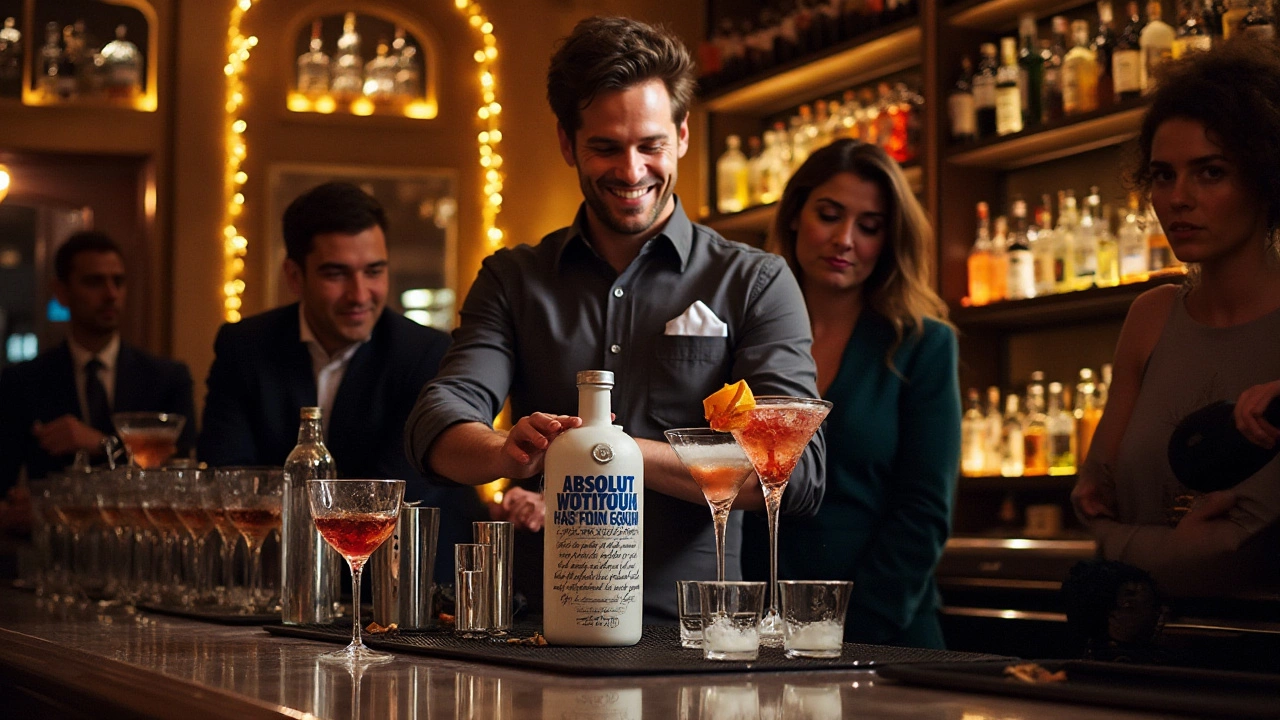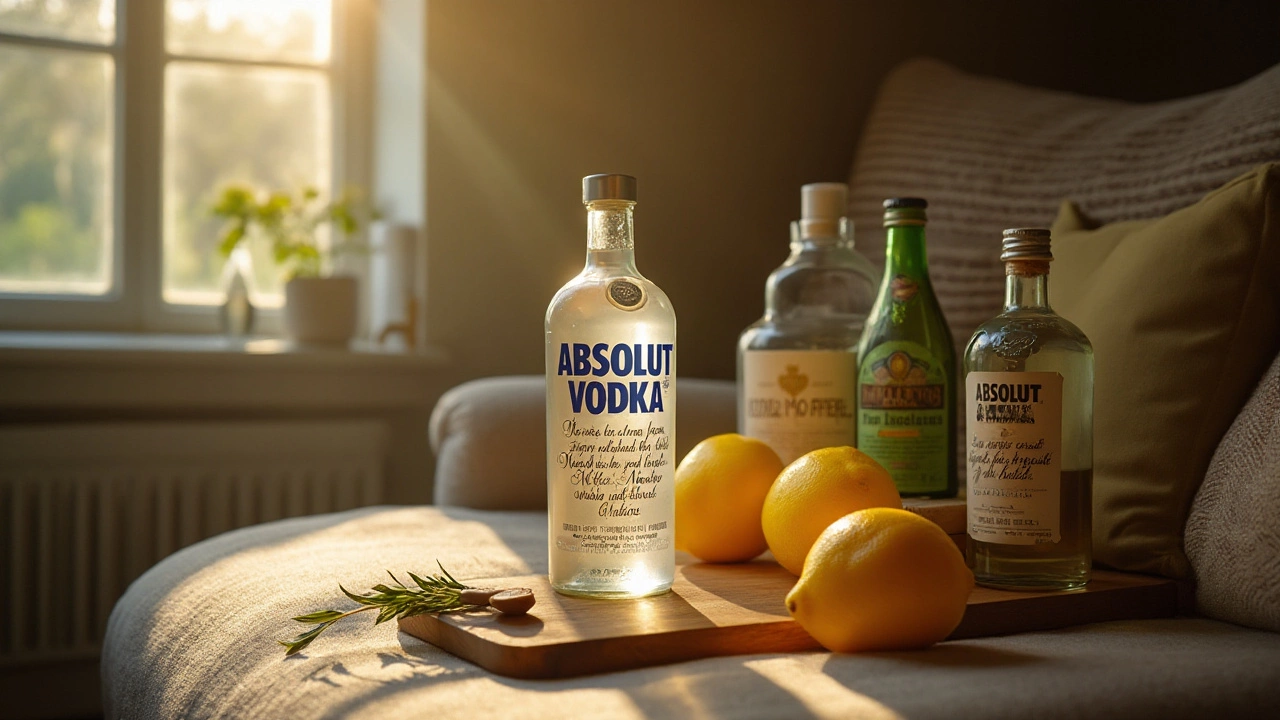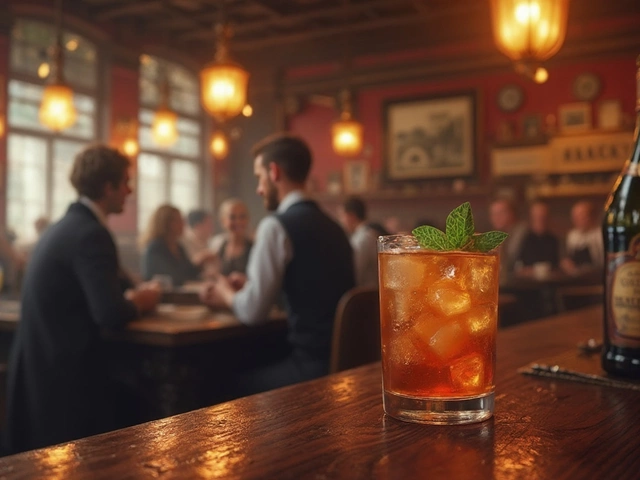Absolut Vodka has been a staple in the spirits industry for decades, capturing the curiosity and taste buds of both occasional drinkers and vodka enthusiasts. In every liquor store, talk of top, middle, and bottom shelf spirits abounds, each designation hinting at price and quality. The term 'bottom shelf' frequently sparks questions about a brand's reputation and worth, and for Absolut, these questions pop up more often than you might think.
But what does it really mean to be a bottom shelf vodka, and where does Absolut fit into this hierarchy? Is it just about the cost, or are there other factors at play? Let's dive into the intriguing world of vodka classifications, taking a closer look at how Absolut's history, production methods, and consumer perceptions paint its picture in the spirits market today.
- A Brief History of Absolut Vodka
- Production Process and Ingredients
- Market Position: Shelf Level Explained
- Perceived Quality and Consumer Opinions
- Comparison with Other Vodka Brands
- Tips for Choosing the Right Vodka
A Brief History of Absolut Vodka
The journey of Absolut Vodka begins in the late 19th century, amid the rolling wheat fields of southern Sweden. It was Lars Olsson Smith, popularly known as "The King of Vodka," who laid the foundation of this iconic brand. Smith pioneered a new distillation process called continuous distillation, which was revolutionary at the time. Unlike the traditional three or four times distillation, this new method produced vodka of remarkable purity, earning Absolut notable acclaim. His innovative technique forever changed vodka production, emphasizing clarity and cleanliness in each drop.
Absolut made its modern debut in 1979, shaking the vodka industry to its core. The company's marketing strategy was nothing short of genius. With its distinctive apothecary-style bottle, Absolut caught the eye of advertisers and drinkers alike. Inspired by an 18th-century medicine bottle, the minimalist design stood apart from the ornate colored bottles common at the time. The advertising campaigns were equally striking – creative partnerships with renowned artists like Andy Warhol helped solidify Absolut’s place not just as a vodka but as a cultural icon.
“I love the bottle, it became more than just the shape of something; it became an art piece,” said Andy Warhol, whose iconic print forever linked Absolut with contemporary art.
In terms of global growth, Absolut’s penetration into the lucrative U.S. market was pivotal. By the 1980s, it became one of America's bestselling imported vodkas. Its identity wasn’t just built on its marketing prowess but also on its commitment to quality ingredients sourced from a single location in Åhus, Sweden. Their 'one source' philosophy means every part of the production, from grain to bottling, maintains consistent high standards. This attention to detail helped Absolut differentiate itself amidst growing competition.
Absolut in the Modern Era
As the world ushered into the new millennium, Absolut continued to evolve, branching out into flavored vodkas that introduced even more enthusiasts to the brand. Today, it offers an array of choices from classic flavors such as lime and mandarin to the more unconventional ones like wild tea. Despite the expanding portfolio, the core of what makes Absolut vodka quintessentially itself has remained unchanged: a commitment to purity, quality, and classic Swedish heritage. The vodka market now teems with brands vying for top shelf space, yet Absolut finds its strength in its roots and continued innovation.
In the 21st century, Absolut remains more than merely a bottle on the shelf. It's an ambassador of Swedish culture and a testament to what visionary thinking and steadfast dedication to tradition can achieve. From revolutionary beginnings to its status as a household name, its history serves as a blueprint for any brand seeking lasting impact in a competitive world. As Lars Olsson Smith would have it, Absolute is not just vodka; it's an experience in itself.
Production Process and Ingredients
When delving into the realm of vodka, understanding how it's made can often demystify its allure and prestige. Absolut Vodka is no exception; it's made in a manner that emphasizes both heritage and innovation. Originating from Sweden, Absolut's production process is rooted deep in the pristine winter wheat fields of Skåne, where the story of each bottle begins. The choice of winter wheat is no coincidence; it's an ingredient chosen for its robust character and consistency, growing with a narrow band of impurities thanks to Sweden's lengthy growing season.
The water used in Absolut is sourced from a local well in Åhus, ensuring each bottle is crafted with purity in mind. Such attention to foundational ingredients sets the stage for a vodka that prides itself on its clean, soft taste. The presence of impurities in vodka can ruin the drinking experience, and Absolut's commitment to filtering out such elements via a meticulous distillation process is noteworthy. Their continuous distillation technique deserves special mention, as it involves multiple rounds of distillation that keep unwanted substances at bay. This process is unique compared to traditional distillation, which may occur in fewer stages, potentially sacrificing purity for speed.
Distillation is where science meets art, and at the heart of Absolut's method lies the art of nuance, where flavors are enhanced rather than stripped away. Absolut Vodka distinguishes itself with this continuous distillation process, a method they assert clears away unwanted by-products more thoroughly than conventional approaches. This results in the spirit's signature smoothness, revered by both casual drinkers and vodka aficionados alike. As noted by Per Hermansson, the master distiller at Absolut, "The commitment to stripping vodka of impurities does not mean stripping it of character."
The absence of added sugar in Absolut Vodka points to another hallmark of its production philosophy, setting it apart from many other brands that might mask less refined distillation practices with sweetness. This dedication to maintaining natural flavors underscores Absolut’s appeal in the cocktail world, where mixologists often seek neutral spirits to form the canvas for their drink creations. Exploring further, one might find that such purity ensures versatility, allowing Absolut Vodka to thrive in a multitude of drink recipes — from the classic vodka tonic to more elaborate concoctions. Another factor that ties into production is their sustainable practices, which aim to reduce environmental impact, a trend growing among conscientious consumers.
This commitment to quality is further evident in their batch-to-bottle traceability, a practice that ensures each stage of production can be tracked back to its origins. Undertakings like these are crucial in maintaining the vodka's esteemed reputation. Such traceability is more than just a marketing point; it's a promise of consistency and integrity. For those who like numbers, consider this: the continuous distillation runs 24/7, resulting in over 500 million bottles annually—a testament to the blend of tradition and technology that defines Absolut. As one sinks into the flavors of Absolut, perhaps they'll even appreciate how every sip is a result of unsurpassed attention to detail that traces back to the fertile lands of southern Sweden.

Market Position: Shelf Level Explained
In the world of spirits, a product's "shelf level" often becomes an unspoken signal to its quality, prestige, and price range. This concept plays a crucial role in how consumers perceive Absolut Vodka. When stepping into a liquor store, the shelves are typically arranged with the premium, pricier brands at eye level, middle-shelf products slightly lower, and budget-friendly options relegated to the bottom. However, Absolut seems to challenge these norms. It’s often found in the mid to upper levels, reflecting its balanced position between premium and accessible categories.
The idea of shelf placement isn’t just a physical arrangement but a branding strategy. Brands invest heavily in ensuring their products appear in favorable positions. Vodka brands like Grey Goose or Belvedere, recognized as premium, strategically occupy these spaces. Absolut, while priced more affordably, consistently manages a placement indicative of quality and reliability. Historically, Absolut has marketed itself as a high-quality yet accessible vodka, a positioning supported by its rich history and sophisticated productions.
The brand’s distinctive status is not arbitrary; Absolut has cultivated its identity through clever marketing and consistent quality. It became particularly famous in the 1980s with inventive advertising campaigns that pushed it far beyond simple market dynamics into a cultural icon. Its Swedish origins and commitment to using only local winter wheat and pristine well water promise purity in every bottle. But such reputation doesn't encircle every shelf—it varies. Market perceptions and even regional product availability might place Absolut Vodka differently. For instance, Absolut often ranks top-tier in bars known for trendy, young crowds drawn by constant nightlife vibrancy, branding itself almost as a rite of passage drink.
A deeper dive reveals a nuanced understanding of this hierarchy also involves the complex blend of subjective experiences and objective quality measures. According to Master of Malt, an online drinks retailer, Absolut’s character and quality are so widely recognized that it effortlessly integrates into the craft cocktail scene while also being palatable enough to be enjoyed neat or with a simple mixer. The concept of 'bottom shelf' is not just attached to price but to the perceived experience and the cultural touchpoints the brand continuously hits.
"Price and prestige do not always align,” explains spirits expert Fred Minnick. “Sometimes, loyal customers find superior tastes in places you'd least expect, turning modest selections like Absolut into household staples."
This insight reflects how brands might rely not solely on their literal shelf position but on deeper, more tangible consumer interactions. The constant reinvention and perseverance of brands like Absolut create a blurred line between categorical placements. Whether Absolut belongs on the bottom shelf depends largely on its perceived value, which is buoyed by favorable user experiences and loyalty, even as it competes against higher-priced competitors.
Perceived Quality and Consumer Opinions
Absolut Vodka, a prominent player in the vodka market, evokes a wide range of opinions from consumers. While some recognize it as a high-quality brand, others might hesitate, labeling it as a more accessible option. It's noteworthy that the brand, which hails from the Åhus region of Sweden, prides itself on its signature clean taste and consistent quality, attributes it achieves through a meticulous distillation process involving locally-sourced winter wheat. Its marketing campaigns have historically highlighted its purity and iconic design, embedding Absolut in the cultural fabric as more than just a drink, but a lifestyle choice. Over time, this positioning has influenced its perception as a reliable option for both casual and formal settings.
Understanding how Absolut balances on the fine line between affordability and quality sheds light on its market position. While it may not match the exclusivity of some ultra-premium vodkas that boast exotic ingredients and complex distillation methods, Absolut's strength lies in its accessibility and timeless appeal. This is echoed across retail shelves worldwide where it frequently features in the middle-tier category. In the eyes of many consumers, this translates to an excellent balance of price and performance. The consensus among vodka enthusiasts tends to be that Absolut delivers a quality experience without unnecessary frills, appealing to both those who enjoy it neat and others who favor it as the base for an array of cocktails.
Consumer reviews often touch upon the unmistakable taste profile of Absolut Vodka, which is smooth with a hint of grain-induced sweetness. This flavor profile has helped establish and maintain its reputation over time. In a study by Drink International, Absolut consistently ranked among the top ten vodkas preferred by bartenders around the world. This widespread acceptance is no coincidence, as it aligns with Absoulte's brand narrative of offering a versatile, reliable choice. Some vodka aficionados might argue that it lacks the complexity of craft vodkas, yet it fills an important niche that balances quality with approachability. Interestingly, in a survey conducted in 2023, 78% of drinkers rated Absolut as providing excellent value for its price point—a testament to its enduring popularity.
"Absolut Vodka is like that trusty old friend who's always on time and never lets you down," notes a review by Mixology Monthly. "It might not steal the show outright, but it always plays its part impeccably."
Such feedback underscores why Absolut has successfully retained its customer base. Part of its allure is its branding—alongside quality—that speaks to consumers' desire for authenticity and dependability. For special occasions or a regular night out, many choose Absolut not just for what it is, but what it symbolizes: a balance between modernity and tradition. This enduring brand loyalty is a testament to how certain perceptions remain deeply ingrained within the vodka sector, persistently elevating brands like Absolut above the purely transactional purchase.

Comparison with Other Vodka Brands
When it comes to understanding where Absolut Vodka stands in comparison to other vodka brands, it requires an examination of several factors including taste, quality, price point, and brand recognition. Absolut places great emphasis on its Swedish roots, maintaining a strong presence both globally and locally. Its grain-to-glass production process, which utilizes winter wheat, is a distinctive aspect that sets it apart from many competitors.
One of the most striking rivalries comes with Grey Goose, another giant in the vodka realm known for its luxurious price tag. While Grey Goose markets itself as ultra-premium with a meticulous production involving soft winter wheat and spring water, Absolut's approach leans on consistency and reliability. Both brands share a commitment to quality, yet their price tags often suggest different customer bases. Grey Goose tends to target those who associate high cost with superior quality, while Absolut appeals to those looking for purity and good taste at a more accessible price.
An interesting contender to consider is Ketel One, a vodka known for its classic European style and smoothness. Derived from 100% wheat, Ketel One prides itself on its elaborate tasting profile, achieved through small batch production. Comparisons here often hinge on personal taste preferences, where some might find Absolut's smooth yet robust flavor a bit more approachable than Ketel One's pronounced character. Both vodkas, however, are frequently lauded for their versatility in cocktails and sipping neat.
"Absolut Vodka consistently bridges the gap between craftsmanship and accessibility, making it a staple in many bars," says a well-known spirit critic at The Spirits Business.
Smirnoff, on the other hand, is another household name that often gets contrasted with Absolut. Known for its mass appeal and affordable pricing, Smirnoff might lack the intricate production narratives of Absolut but makes up for it through its wide range of flavored vodkas and practical mixability. The competition here illustrates the diverse consumer needs in the vodka market, where not every drinker prioritizes origin story or minor grain differences. Instead, Smirnoff’s strategy revolves around delivering consistency at a lower price point, which might explain why it often shares shelf space with Absolut, catering to both budget-conscious buyers and those seeking a touch of European authenticity.
Sometimes, comparisons bring into play lesser-known but rising brands like Tito's Handmade Vodka. As a craft vodka originating from Texas, Tito's emphasizes its corn-based process and gluten-free promise, creating a smoother drink with a distinct profile. In head-to-head match-ups, Absolut's smoother texture and traditional wheat base offer a totally different experience, showcasing the diverse nature of vodka production methods. Each brand has its own unique charm, yet they all manage to coexist, fulfilling various niches within the vodka-loving community. This vibrant variety enriches the spirits market and ensures that there is a vodka that caters to every palate preference and price consideration.
Tips for Choosing the Right Vodka
Choosing the right vodka can often seem daunting with so many options on the market. Whether you're a newcomer to the world of spirits or a seasoned connoisseur, knowing what to look for when selecting the perfect bottle is crucial. A great first step is understanding your own palate; some people prefer a vodka with a smooth finish, while others might lean towards ones with a bolder character. This involves not just tasting different types but also familiarizing yourself with common flavor profiles and production methods used by various brands.
One thing that shouldn't be overlooked is the vodka's origin. Certain regions are renowned for their vodka production, offering unique methods that influence flavor. Russia, Poland, and Sweden—home to Absolut Vodka—are particularly notable for their distinct contributions to vodka's taste landscape. Each country employs specific fermenting techniques and ingredients which impact the final beverage's tone. According to Dmitri Mendeleev, a respected Russian chemist, "Vodka is not just a distilled spirit; it’s a distilled culture."
Cultural nuances, ingredients, and historic practices determine each bottle's soul, offering consumers more than just alcohol—it’s a narrative poured into a glass.
When perusing shelves, evaluating price against taste and purpose can also guide your selection. Are you searching for a mixer for cocktails or a spirit to be enjoyed neat or over ice? For mixers, sometimes a mid-range option like Absolut serves well due to its balance between smoothness and affordability. A higher shelf bottle might boast richer flavors, ideal for sipping slowly to savor each nuance. Comparing vodka brands through taste tests can be surprisingly enlightening and is encouraged to refine your preferences and align your expectations realistically.
An often-overlooked aspect is the method of distillation. Continuous distillation typically produces a cleaner vodka, while pot distillation might leave more character and complexity – these subtle differences dramatically sway the drinking experience. Additionally, filtering—through substances like charcoal or even diamonds—can influence purity and smoothness. Consider if additives are present; some prefer a purely clean spirit, while others enjoy those with added fruit essences or spices. It’s a personal choice that shapes the overarching enjoyment of the vodka.
A quick glance at a vodka pricing table can sometimes provide clarity, as illustrated below:
| Quality | Price Range |
|---|---|
| Economy | $5 - $15 |
| Mid-range | $15 - $30 |
| Premium | $30 and above |
This table helps decipher where certain brands sit economically, assisting in deciding whether you're paying for exceptional quality or primarily for a brand name. Lastly, keep an eye on awards and reviews from reputable spirit competitions which can be a testament to quality. These accolades often validate the reputation of a vodka that critics and laymen alike find commendable. Selecting the right vodka is, at its heart, a balance between personal enjoyment and informed judgement – factors that ensure an enriching drinking experience every time.


